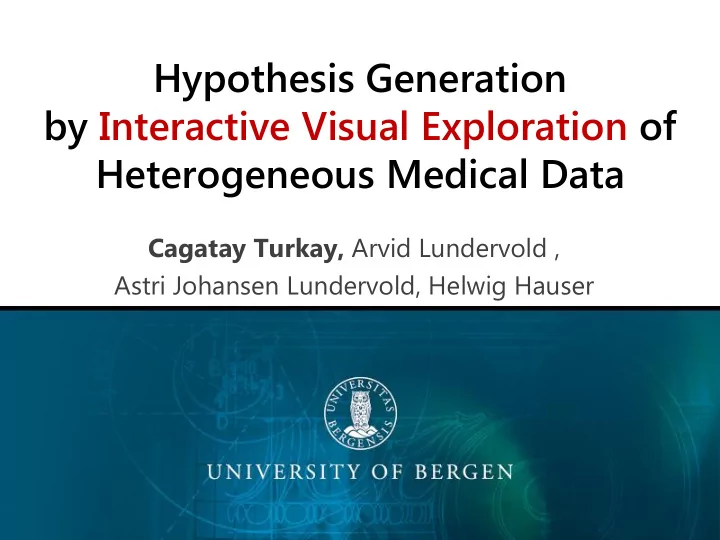

Hypothesis Generation by Interactive Visual Exploration of Heterogeneous Medical Data Cagatay Turkay, Arvid Lundervold , Astri Johansen Lundervold, Helwig Hauser
What you will hear today? • Interactive & visual methods in data analysis Dual analysis approach • • Deal with complex datasets Many variables • Heterogeneous • Several modalities • • Generating hypotheses interactively • Analyze medical data as a multidisciplinary group
Problem Domain: Cognitive Aging Study Analysis • Carried out by neuropsychology & biomedicine experts • Analyze relations between brain segments vs. cognitive decline • Heterogeneous : image statistics + test scores + patient data Imaging modalities, MRI, DTI, fMRI • Neuropsychological examination: IQ, memory function, and • attention/executive function • Longitudinal study, 3 waves ( 2005 , 2009, 2012) ~100 participants •
Cognitive Aging Study Data MR Imaging Anatomical Segmentation -- 45 brain segments, e.g., cerebellum, white matter, … -- 7 features for each 2D data segment e.g., number of table voxels , volume, … + + 82 𝒀 373 Neuropsychological Personal/Clinical Examination Data
Problems in the analysis process • Slow analysis pipeline • Analysis limited to a priori hypothesis, i.e., already published research • Relating different types of data (variables) is challenging • Work on a subset of data at each iteration of the analysis, lose the overall picture • Computational tools are often black-boxes
Interactive Visual Analysis Methods (In a Nutshell) • Multiple visualizations of data • Selections denoted as focus + context • Linked selections within views • Integrated use of computational tools “R for Statistical Computing” • PCA, MDS, Clustering, Regression, etc… • Different views
Dual Analysis Method • Treat variables as first-order analysis objects • Interactive visual analysis in two linked spaces
Dual Analysis Method Items Variables D stat 2 2 n points (#dims) D stat … D D D 1 1 n 1 2 A single variable A single data item
Visualizations in the dimensions space • Dimensions are the main visual entities !! Variables with smaller values and high variance IQR Normalize data first Variables with higher values and low variance For each column, compute med and IQR med
Rich statistics set = rich analysis • Different statistics for different insights Descriptive statistics, e.g., skewness, kurtosis • Robust statistics: e.g., median, IQR, etc. • Distribution test scores , e.g., normality • Correlation relations • … For each column, • compute k statistics • Include also the meta-data Normality Skewness Kurtosis
Deviation Plot Higher values for the selection Compute “µ” & “α” values using two subsets of items Change in “ α ” values Item Item Subset-1 Subset-2 Change in “µ” values = - 12
Cognitive Aging Study Data MR Imaging Anatomical Segmentation -- 45 brain segments, e.g., cerebellum, white matter, … -- 7 features for each 2D data segment e.g., number of table voxels , volume, … + + 82 𝒀 373 Personal/Clinical Neuropsychological Data Examination
Analysis Process • Generate new hypotheses exploratively Data-driven process • Consider a priori expert knowledge • • Use meta-data on dimensions to steer analysis Dependent / independent variables • • 5 hypotheses in short sessions Inter-relations in Test Results • Findings Based on Sex • Findings Based on Age • IQ & Memory Function vs. Brain Segment Volumes • Relations within Brain Segments •
Findings Based on Age
Relations within Brain Segments
Observations & Limitations • No need for limitations on a priori knowledge • Whole data available along the analysis • Change in working routine ! Hypothesis driven analysis to hypothesis • generation • Quickly check for known hypotheses – data quality ? • Learning curve ? Understanding of statistics • Overfitting to data / non-optimal solutions
Lessons Learned (for the future) • Need to incorporate robust methods / tools • Enable more accurate readings • Reduce false positives • Improve usability & visual guidance Only significant Local/interactive differences regression analysis
Conclusions • Applicable/generalizable methods to data from other scientific fields • Interactive use of computational tools, more reliable, easier to interpret • Quick hypotheses generation, prototyping ideas Then use robust (slow) methods if necessary • • S weet spot between “ hypothesis-driven ” & “ data- driven ” science
Acknowledgments • Peter Filzmoser, TU Wien • Julius Parulek, VisGroup @ UIB • VisGroup @ UIB
Recommend
More recommend